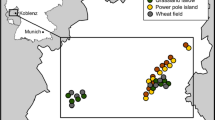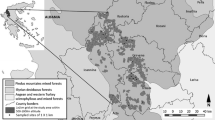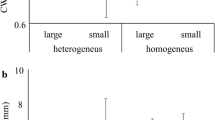Abstract
Protected areas alone cannot conserve all biodiversity; we must also conserve biodiversity within production landscapes. Little is known about spider diversity in the Cape Floristic Region (CFR) biodiversity hotspot and factors driving spider diversity in transformed landscapes. Here, we assess spatial patterns of spiders in different transformed biotopes bordering remnant fynbos natural vegetation patches, determine direction of associated edge effects, and identify environmental factors influencing spider local distribution. Spiders were sampled along replicated transects running from remnant patches into three different transformed biotopes: old-fields (abandoned farmland), vineyards, and alien tree plantations. Spider Shannon diversity within old-fields and plantations did not differ from remnant patches, which had the highest diversity, whereas vineyards had the lowest. Overall, spider diversity was consistently high around habitat boundaries, regardless of land use type. Vineyards showed sharp declines in spider diversity along the remnant-vineyard transect, compared to other transects. Spider assemblages within vineyards was significantly different compared to remnant patches and old-fields, whereas other land-uses showed greater similarity. Plant species richness within the transformed biotope core increased overall spider diversity, benefiting plant-dwelling assemblages, but negatively influencing ground-dwelling assemblages. Herbaceous plant cover was driving assemblages within vineyards, whereas Restionaceae plant cover drove assemblages within old-fields. Furthermore, amount of natural vegetation in the landscape influenced spider assemblages within transformed biotopes. Our results show that old-fields have great potential to increase structural and functional connectivity within agricultural mosaics, and their rehabilitation is recommended. Furthermore, increasing plant diversity throughout the transformed landscape can soften the landscape and benefit spider diversity.





Similar content being viewed by others
Data availability
Data will be made available upon request.
References
Adu-Acheampong S, Samways MJ, Landmann T, Kyerematen R, Minkah R, Mukundamago M, Moshobane CM (2017) Endemic grasshopper species distribution in an agro-natural landscape of the Cape Floristic Region, South Africa. Ecol Eng 105:133–140. https://doi.org/10.1016/j.ecoleng.2017.04.037
Arvidsson F, Addison P, Addison M, Haddad CR, Birkhofer K (2020) Weed species, not mulching, affect web-building spiders and their prey in organic fruit orchards in South Africa. Ecosphere 11(3):e03059. https://doi.org/10.1002/ecs2.3059
Balmford B, Green RE, Onial M, Phalan B, Balmford A (2018) How imperfect can land sparing be before land sharing is more favourable for wild species? J Appl Ecol 56:73–84. https://doi.org/10.1111/1365-2664.13282
Barton K (2019) MuMIn: multi-model inference. R package version 1.43.6. https://CRAN.R-project.org/package=MuMIn
Birkhofer K, Gossner MM, Diekötter T, Drees C, Ferlian O, Maraun M, Scheu S, Weisser WW, Wolters V, Wurst S, Zaitsev AS, Smith HG (2017) Land-use type and intensity differentially filter traits in above- and below-ground arthropod communities. J Anim Ecol 86:511–520. https://doi.org/10.1111/1365-2656.12641
Birkhofer K, Fevrier V, Heinrich AE, Rink K, Smith HG (2018) The contribution of CAP greening measures to conservation biological control at two spatial scales. Agric Ecosyst Environ 255:84–94. https://doi.org/10.1016/j.agee.2017.12.026
Blandenier G (2009) Ballooning of spiders (Araneae) in Switzerland: general results from an eleven-year survey. Br Arachnol Soc 14:308–316. https://doi.org/10.13156/arac.2009.14.7.308
Brooks ME, Kristensen K, van Benthem KJ, Magnusson A, Berg CW, Nielsen A, Skaug HJ, Mächler M, Bolker BM (2017) glmmTMB Balances speed and flexibility among packages for zero-inflated generalized linear mixed modelling. R J 9:378–400
Cardoso P, Barton PS, Birkhofer K, Chichorro F, Deacon C, Fartmann T, Fukushima CS, Gaigher R, Habel JC, Hallmann CA, Hill MJ, Hochkirch A, Kwak ML, Mammola S, Noriega JA, Orfinger AB, Pedraza F, Pryke JS, Roque FO, Simaika SJ, JP, Stork NE., Suhling F, Vorster C, Samways MJ, (2020) Scientists’ warning to humanity on insect extinctions. Biol Conserv 242:108426. https://doi.org/10.1016/j.biocon.2020.108426
Carvalheiro LG, Veldman R, Shenkute AG, Tesfay GB, Pirk CWW, Donaldson JS, Nicolson SW (2011) Natural and within-farmland biodiversity enhances crop productivity. Ecol Lett 14:251–259. https://doi.org/10.1111/j.1461-0248.2010.01579.x
Crous CJ, Samways MJ, Pryke JS (2013) Exploring the mesofilter as a novel operational scale in conservation planning. J Appl Ecol 50:205–214. https://doi.org/10.1111/1365-2664.12012
Dennis P, Fry GL (1992) Field margins: can they enhance natural enemy population densities and general arthropod diversity on farmland? Agric Ecosyst Environ 40:95–115. https://doi.org/10.1016/0167-8809(92)90086-Q
Dippenaar-Schoeman AS, Haddad CR, Foord S, Lyle R, Lotz L, Helberg L, Mathebula S, van den Berg A, Marais P, van den Berg AM, van Niekerk E, Jocqué R (2010) First atlas of the spiders of South Africa (Arachnida: Araneae). South African National Survey of Arachnida Technical Report 2010 version 1
Dippenaar-Schoeman AS, van den Berg AM, Haddad CR, Lyle R (2013) Current knowledge of spiders in South Africa agroecosystems (Arachnida: Araneae). Trans R Soc S Afr 68:57–74. https://doi.org/10.1080/0035919X.2012.755136
Dippenaar-Schoeman AS, Haddad CR, Foord SH, Lyle R, Lotz LN, Marais P (2015) South African National Survey of Arachnida (SANSA): review of current knowledge, constraints and future needs for documenting spider diversity (Arachnida: Araneae). Trans R Soc S Afr 70:245–275. https://doi.org/10.1080/0035919X.2015.1088486
Dominik C, Seppelt R, Horgan FG, Settele J, Václavík T (2018) Landscape composition, configuration, and trophic interactions shape arthropod communities in rice agroecosystems. J Appl Ecol 55:2461–2472. https://doi.org/10.1111/1365-2664.13226
Driscoll DA, Banks SC, Barton PS, Lindenmayer DB, Smith AL (2013) Conceptual domain of the matrix in fragmented landscapes. Trends Ecol Evol 28:605–613. https://doi.org/10.1016/j.tree.2013.06.010
Duelli P, Obrist MK (2003) Regional biodiversity in an agricultural landscape: the contribution of seminatural habitat islands. Basic Appl Ecol 4:129–138. https://doi.org/10.1078/1439-1791-00140
Ekroos J, Ödman AM, Andersson GKS, Birkhofer K, Herbertsson L, Klatt BK, Olsson O, Olsson PA, Persson AS, Prentice HC, Rundlöf M, Smith HG (2016) Sparing land for biodiversity at multiple spatial scales. Front Ecol Evol 3:145. https://doi.org/10.3389/fevo.2015.00145
Entling W, Schmidt MH, Bacher S, Brandl R, Nentwig W (2007) Niche properties of Central European spiders: shading, moisture and the evolution of the habitat niche. Glob Ecol Biogeogr 16:440–448. https://doi.org/10.1111/j.1466-8238.2006.00305.x
Evans TR, Mahoney MJ, Cashatt ED, Noordijk J, de Snoo G, Musters CJM (2016) The impact of landscape complexity on invertebrate diversity in edges and fields in an agricultural area. Insects 7:1–16. https://doi.org/10.3390/insects7010007
Fischer J, Brittain C, Klein A (2013) Biodiversity-friendly farming. Encyclopaedia of biodiversity. Academic Press, Boca Raton, pp 418–429
Foord SH, Dippenaar-Schoeman AS, Haddad CR (2011) South African spider diversity: African perspectives on the conservation of a mega-diverse group. Changing diversity in a changing environment. Intech, Croatia, pp 163–182
Gaigher R, Samways MJ (2010) Surface-active arthropods in organic vineyards, integrated vineyards and natural habitat in the Cape Floristic Region. J Insect Conserv 14:595–605. https://doi.org/10.1007/s10841-010-9286-2
Gaigher R, Samways MJ (2014) Landscape mosaic attributes for maintaining ground living spider diversity in a botanical hotspot. Insect Conserv Divers 7:470–479. https://doi.org/10.1111/icad.12070
Gaigher R, Pryke JS, Samways MJ (2015) High parasitoid diversity in remnant natural vegetation, but limited spillover into the agricultural matrix in South African vineyard agroecosystems. Biol Conserv 186:69–74. https://doi.org/10.1016/j.biocon.2015.03.003
Gaigher R, Pryke JS, Samways MJ (2016) Old fields increase habitat heterogeneity for arthropod natural enemies in an agricultural mosaic. Agric Ecosyst Environ 230:242–250. https://doi.org/10.1016/j.agee.2016.06.014
Gallé R, Happe A, Baillod AB, Tscharntke T, Batáry P (2019) Landscape configuration, organic management, and within-field position drive functional diversity of spiders and carabids. J Appl Ecol 56:63–72. https://doi.org/10.1111/1365-2664.13257
Garibaldi LA, Pérez-Méndez N, Garratt MPD, Gemmill-Herren B, Miguez FE, Dicks LV (2019) Policies for ecological intensification of crop production. Trends Ecol Evol 34:282–286. https://doi.org/10.1016/j.tree.2019.01.003
Goldblatt P (1997) Floristic diversity in the Cape flora of South Africa. Biodivers Conserv 6:359–377. https://doi.org/10.1023/A:1018360607299
Guiller C, Affre L, Albert CH, Tatoni T, Dumas E (2016) How do field margins contribute to the functional connectivity of insect-pollinated plants? Landsc Ecol 31:1747–1761. https://doi.org/10.1007/s10980-016-0359-9
Haddad CR, Brabec M, Pekár S, Fourie R (2016) Seasonal population dunamics of a specialized termite-eating spider (Araneae: Ammozenidae) and its prey (Isoptera: Hodotermidtidae). Pedobiologia 59:105–110. https://doi.org/10.1016/j.pedobi.2016.03.003
Helm J, Dutoit T, Saatkamp A, Bucher SF, Leiterer M, Römermann C (2019) Recovery of Mediterranean steppe vegetation after cultivation: legacy effects on plant composition, soil properties and functional traits. Appl Veg Sci 27:71–84. https://doi.org/10.1111/avsc.12415
Hogg BN, Daane KM (2010) The role of dispersal from natural habitat in determining spider abundance and diversity in California vineyards. Agric Ecosyst Environ 135:260–267. https://doi.org/10.1016/j.agee.2009.10.004
Isaacs R, Tuell J, Fiedler A, Gardiner M, Landis D (2008) Maximizing arthropod-mediated ecosystem services in agricultural landscapes: the role of native plants. Front Ecol Environ 7:196–203. https://doi.org/10.1890/080035
Katayama N, Bouam I, Koshida C, Baba YG (2019) Biodiversity and yield under land-use types in orchard/vineyard landscapes: a meta-analysis. Biol Conserv 229:125–133. https://doi.org/10.1016/j.biocon.2018.11.020
Kehinde T, Samways MJ (2012) Endemic pollinator response to organic vs. conventional farming and landscape context in the Cape Floristic Region biodiversity hotspot. Agric Ecosyst Environ 146:162–167. https://doi.org/10.1016/j.agee.2011.10.020
Kehinde T, Samways MJ (2014) Effects of vineyard management on biotic homogenization of insect–flower interaction networks in the Cape Floristic Region biodiversity hotspot. J Insect Conserv 18:469–477. https://doi.org/10.1007/s10841-014-9659-z
Magoba RN, Samways MJ (2012) Comparative footprint of alien, agricultural and restored vegetation on surface-active arthropods. Biol Invasions 14:165–177. https://doi.org/10.1007/s10530-011-9994-x
Magoba RN, Samways MJ, Simaika JP (2015) Soil compaction and surface-active arthropods in historic, agricultural, alien, and recovering vegetation. J Insect Conserv 19:501–508. https://doi.org/10.1007/s10841-015-9771-8
Martin AE, Fahrig L (2015) Matrix quality and disturbance frequency drive evolution of species behavior at habitat boundaries. Ecol Evol 5:5792–5800. https://doi.org/10.1002/ece3.1841
Midoko-Iponga D, Krug CB, Milton SJ (2005) Competition and herbivory influence growth and survival of shrubs on old fields: Implications for restoration of renosterveld shrubland. J Veg Sci 16:685–692. https://doi.org/10.1111/j.1654-1103.2005.tb02411.x
Myers N, Mittermeier RA, Mittermeier CG, da Fonseca GAB, Kent J (2000) Biodiversity hotspots for conservation priorities. Nature 403:853–858. https://doi.org/10.1038/35002501
Nyffeler M, Sunderland KD (2003) Composition, abundance and pest control potential of spider communities in agroecosystems: a comparison of European and US studies. Agric Ecosyst Environ 95:579–612. https://doi.org/10.1016/S0167-8809(02)00181-0
Oksanen J, Blanchet FG, Friendly M, Kindt R, Legendre P, McGlinn D, Minchin PR, O’Hara RB, Simpson GL, Solymos P, Stevens MHH, Szoecs E, Wagner H (2019) vegan: Community Ecology Package. R package version 2.5-6. https://CRAN.R-project.org/package=vegan
Oliver I, Beattie AJ (1996) Invertebrate morphospecies as surrogates for species: a case study. Conserv Biol 10:99–109. https://doi.org/10.1046/j.1523-1739.1996.10010099.x
Oxbrough AG, Gittings T, O’Halloran J, Giller PS, Smith GF (2005) Structural indicators of spider communities across the forest plantation cycle. For Ecol Manag 212:171–183. https://doi.org/10.1016/j.foreco.2005.03.040
Paiola A, Assandri G, Brambilla M, Zottini M, Pedrini P, Nascimbene J (2020) Exploring the potential of vineyards for biodiversity conservation and delivery of biodiversity-mediated ecosystem services: a global-scale systematic review. Sci Total Environ 706:135839. https://doi.org/10.1016/j.scitotenv.2019.135839
Paradis E, Schliep K (2018) ape 5.0: an environment for modern phylogenetics and evolutionary analyses in R. Bioinformatics 35:526–528. https://doi.org/10.1093/bioinformatics/bty633
Pardini R, Faria D, Accacio GM, Laps RR, Mariano-Neto E, Paciencia MLB, Dixo M, Baumgarten J (2009) The challenge of maintaining Atlantic forest biodiversity: a multi-taxa conservation assessment of specialist and generalist species in an agro-forestry mosaic in southern Bahia. Biol Conserv 142:1178–1190. https://doi.org/10.1016/j.biocon.2009.02.010
Perfecto I, Vandermeer J (2010) The agroecological matrix as alternative to the land sparing/agriculture intensification model. Proc Natl Acad Sci USA 107:5786–5791. https://doi.org/10.1073/pnas.0905455107
Phalan B, Balmford A, Green RE, Scharlemann JW (2011) Minimising the harm to biodiversity of producing more food globally. Food Policy 36:S62–S71. https://doi.org/10.1016/j.foodpol.2010.11.008
Pimm SL, Jenkins CN, Abell R, Brooks TM, Gittleman JL, Joppa LN, Raven PH, Roberts CM, Sexton JO (2014) The biodiversity of species and their rates of extinction, distribution, and protection. Science 344:1246752
R Core Team (2013) R: a language and environment for statistical computing. R Foundation for Statistical Computing, Vienna, Austria. https://www.r-project.org/
Rosas-Ramos N, Baños-Picón L, Tobajas E, de Paz V, Tormos J, Asís JD (2018) Value of ecological infrastructure diversity in the maintenance of spider assemblages: a case study of Mediterranean vineyard agroecosystems. Agric Ecosyst Environ 265:244–253. https://doi.org/10.1016/j.agee.2018.06.026
Rouget M, Richardson DM, Cowling RM, Lloyd JW, Lombard AT (2003) Current patterns of habitat transformation and future threats to biodiversity in terrestrial ecosystems of the Cape Floristic Region, South Africa. Biol Conserv 112:63–85. https://doi.org/10.1016/S0006-3207(02)00395-6
Samways MJ (2015) Future-proofing insect diversity. Curr Opin Insect Sci 12:71–78. https://doi.org/10.1016/j.cois.2015.09.008
Saura S, Bodin O, Fortin M (2014) Stepping stones are crucial for species long distance dispersal and range expansion through habitat networks. J Appl Ecol 51:171–182. https://doi.org/10.1111/1365-2664.12179
Schmidt MH, Roschewitz I, Thies C, Tscharntke T (2005) Differential effects of landscape and management on diversity and density of ground-dwelling farmland spiders. J Appl Ecol 42:281–287. https://doi.org/10.1111/j.1365-2664.2005.01014.x
Schmidt MH, Thies C, Nentwig W, Tscharntke T (2008) Contrasting responses of arable spiders to the landscape matrix at different spatial scales. J Biogeogr 35:157–166. https://doi.org/10.1111/j.1365-2699.2007.01774.x
Tews J, Brose U, Grimm V, Tielbörger K, Wichmann MC, Schwager M, Jeltsch F (2004) Animal species diversity driven by habitat heterogeneity/diversity: the importance of keystone structures. J Biogeogr 31:79–92. https://doi.org/10.1046/j.0305-0270.2003.00994.x
Theron KJ, Gaigher R, Pryke JS, Samways MJ (2020) High quality remnant patches in a complex agricultural landscape sustain high spider diversity. Biol Conserv 243:108480. https://doi.org/10.1016/j.biocon.2020.108480
Tischendrof L, Fahrig L (2000) On the usage and measurement of landscape connectivity. Oikos 90:7–19. https://doi.org/10.1034/j.1600-0706.2000.900102.x
Vasseur C, Joannon A, Aviron S, Burel F, Maynard J, Baudry J (2013) The cropping system mosaic: how does the hidden heterogeneity of agricultural landscapes drive arthropod populations? Agric Ecosyst Environ 166:3–14. https://doi.org/10.1016/j.agee.2012.08.013
Vrdoljak SM, Samways MJ (2014) Agricultural mosaics maintain significant flower and visiting insect biodiversity in a global hotspot. Biodivers Conserv 23:133–148. https://doi.org/10.1007/s10531-013-0588-z
Wang Y, Naumann U, Wright S, Warton DI (2012) mvabund: an R package for model-based analysis of multivariate data. Methods Ecol Evol 3:471–474. https://doi.org/10.1111/j.2041-210X.2012.00190.x
Winter S, Bauer T, Strauss P, Kratschmer S, Paredes D, Popescu D, Landa B, Guzmán G, Gómez JA, Guernion M, Zaller JG, Batáry P (2018) Effects of vegetation management intensity on biodiversity and ecosystem services in vineyards: a meta-analysis. J Appl Ecol 55:2484–2495. https://doi.org/10.1111/1365-2664.13124
Acknowledgements
This project was funded by Mondi Group. Fauna specimens were collected with permit no. AAA007-00144-0056 provided by Cape Nature. Spider species were identified by Prof Ansie Dippenaar-Schoeman. Centre for Geographical Analysis provided access to Stellenbosch University 5 m resolution digital elevation model. Lastly, access to sampling locations granted by multiple landowners and wine farms.
Funding
This work was funded by Mondi Group.
Author information
Authors and Affiliations
Contributions
KJT: conceptualization, methodology, formal analysis, investigation, writing—original draft, writing—review & editing, visualization. RG: conceptualization, methodology, validation, formal analysis, resources, writing—review & editing. JSP: conceptualization, methodology, validation, formal analysis, writing—review & editing. MJS: conceptualization, methodology, validation, writing—review & editing, funding acquisition.
Corresponding author
Ethics declarations
Conflicts of interest
Not applicable.
Additional information
Communicated by Nigel E. Stork.
Publisher's Note
Springer Nature remains neutral with regard to jurisdictional claims in published maps and institutional affiliations.
Appendix
Appendix
See Figs. 6, 7, 8, 9 and Tables 5, 6, 7.
Significant results obtained through generalized linear mixed effect models. Characters above box plots indicate significant differences. a Plant-dwelling exponent of the Shannon index and land use type, b Plant-dwelling exponent of the Shannon index and transect location, c Overall exponent of the Shannon index and plant richness, and d Plant-dwelling exponent of the Shannon index and plant richness
Rights and permissions
About this article
Cite this article
Theron, K.J., Gaigher, R., Pryke, J.S. et al. Abandoned fields and high plant diversity support high spider diversity within an agricultural mosaic in a biodiversity hotspot. Biodivers Conserv 29, 3757–3782 (2020). https://doi.org/10.1007/s10531-020-02048-9
Received:
Revised:
Accepted:
Published:
Issue Date:
DOI: https://doi.org/10.1007/s10531-020-02048-9








